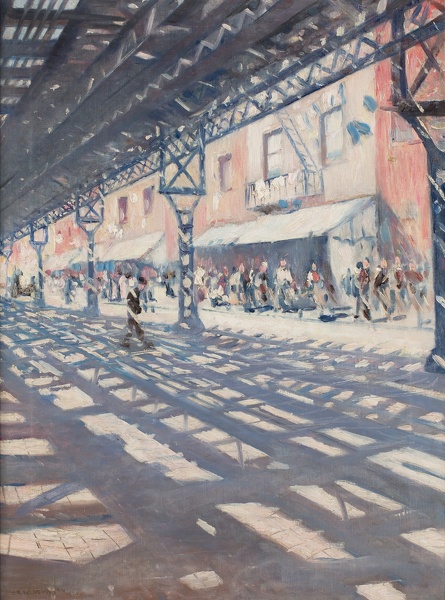
Third Avenue, Elevated Railway, 1920
Framed (ref: 8024)
Signed and dated 1920
Tags: Christopher Richard Wynne Nevinson oil architecture men Metropolitan The Alan M. Fortunoff Collection

Tags: Christopher Richard Wynne Nevinson oil architecture men Metropolitan The Alan M. Fortunoff Collection
Provenance: The Fortunoff collection [HF26]
Exhibited : New York, Bourgeois Gallery, The Old World and the New, Nov-Dec 1920, where purchased by C. B. Cochran. Cambridge, Kettles Yard, C.R.W. Nevinson: A Retrospective Exhibition, Sep-Oct 1988 London, Imperial War Museum, C.R.W Nevinson, The Twentieth Century, October 1999-,January 2000, No. 86 (colour plate, p.142).

Following the popular success of his two exhibitions of First World War paintings and drawings at the Leicester Galleries in 1916 and March 1918, Nevinson made two trips to New York, the first in 1919 and again the following year. His first visit was to attend the exhibition of his etchings and lithographs at Keppel & Co with a catalogue introduction by the well known critic and connoisseur Albert Gallatin. A larger exhibition of ninety four works - paintings, etchings, lithographs and woodcuts - was held the following year (10 November - 4 December) at the Bourgeois Gallery, where this work was first exhibited. Nevinson and his wife had sailed for New York in September, so this evocative view of the ‘Old El’ must have been painted soon after their arrival. Unlike a number of his works, which were carefully and somewhat self-consciously, created as studio compositions, such as Tate Britain’s Soul of the Soulless City, Third Avenue, Elevated Railway captures the immediacy and excitement of the scene with its bustle and noise. One senses that it was set down enthusiastically directly in front of the subject, with every brushstroke capturing the mood of dappled sunshine and shadows as well as the multiplicity of colourful figures on the sidewalk beyond.
This contrast between á la prima and studio works is commented on by Chloe Johnson in her essay The Soul of the Soulless City, (op. cit pp. 10-11): ‘Third Avenue, Elevated Railway shows a specific site, with colourful shadows under the rail track and picturesque pedestrians. More akin to the paintings of the Ashcan School and the work of early twentieth century British artists such as Walter Sickert and the Camden Town Group, this image is a fleeting glimpse of a moment of modern urban life.’ Jonathan Black (op.cit. p. 77) notes its stylistic links to the works of both Robert Henri and John Sloan, whom Nevinson had met on his previous visit to New York.
The Third Avenue Elevated Railway - the El - built in the 1870s, ran from Chatham Square in the City Hall area of Manhattan to Gun Hill and White Plains in the Bronx until it was gradually demolished, section by section, over a twenty-three year period from 1950. Jack Finney in his 1970 time-warp novel, Time and Again, vividly summons up memories of the ‘incongruous clatter’ if you were on the street below, as trains thundered overhead, as well as recalling images of its old stations. He described these in detail with their bare worn floorboards, wooden tongue-and-groove walls, and little scooped-out shelves ‘projecting from under the change-booth window, grained and polished from ten thousand hands.’ Today, with its cavernous streets and anonymous high- rise buildings, such images of a vanished New York increasingly evoke a strong feeling of nostalgia.

An etching, titled 'Under the Elevated', issued in an edition of 75, was included in the 1921 New York series of dry points by Nevinson.